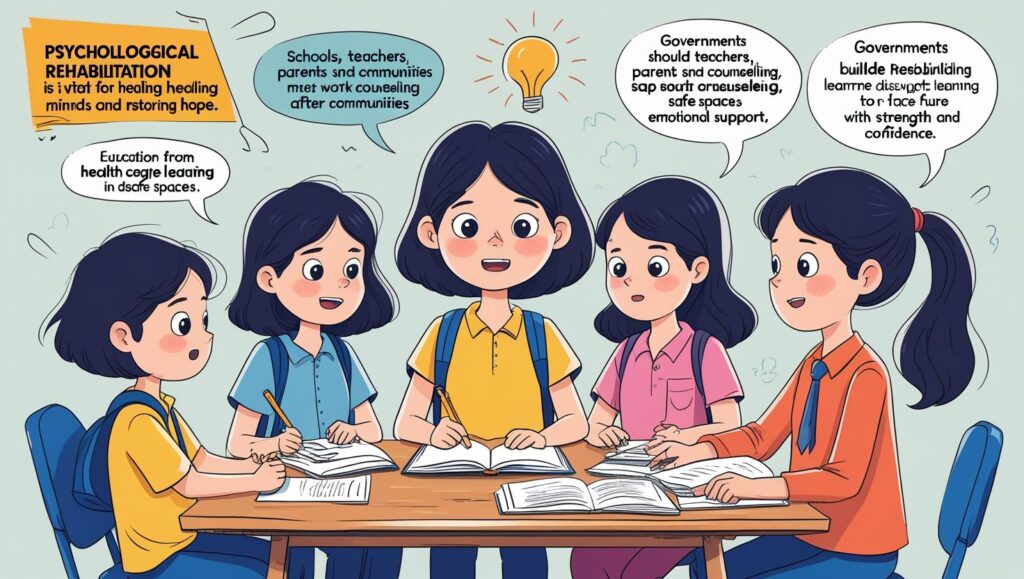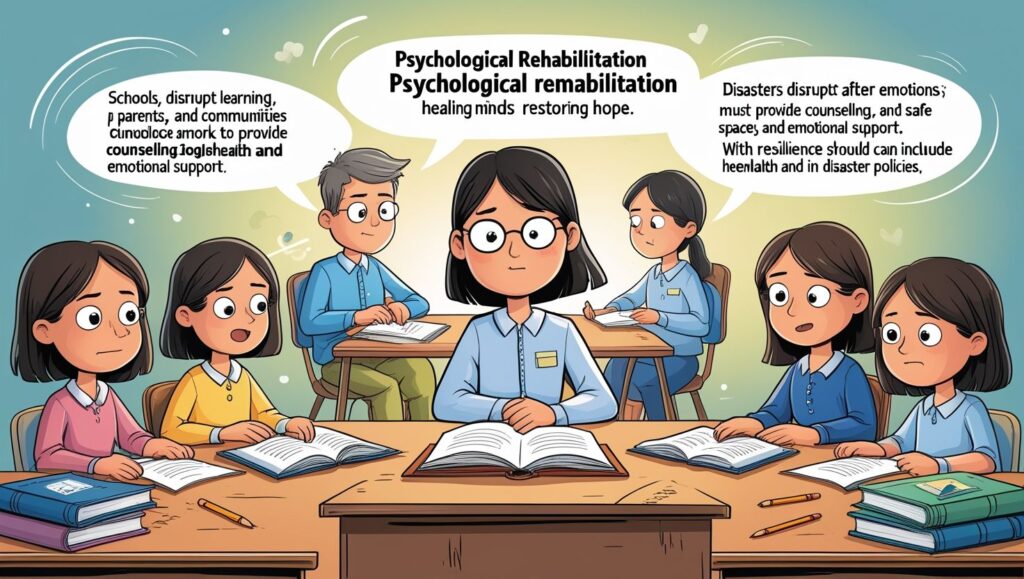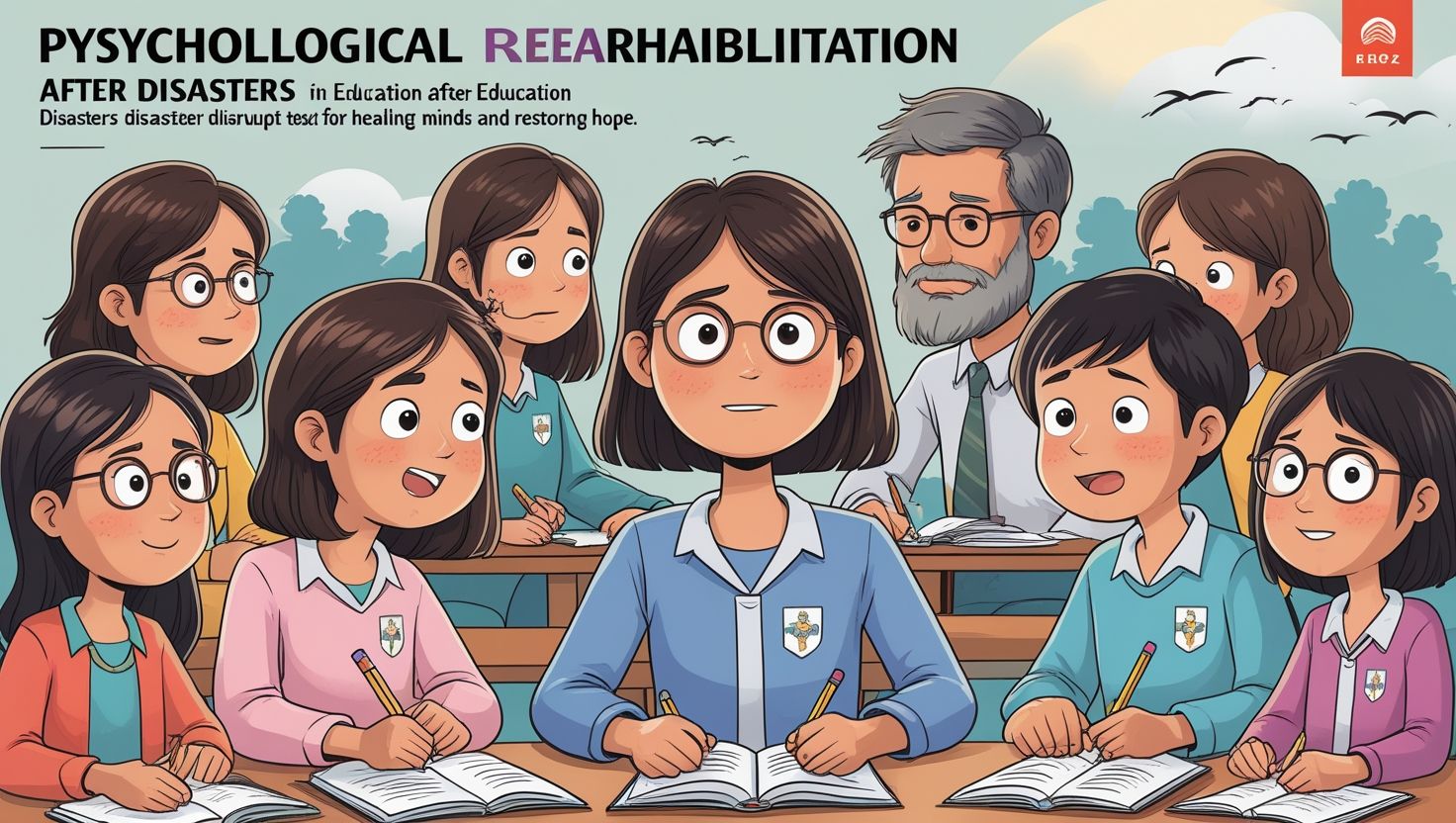Introduction
Psychological Rehabilitation after Disasters in Education, Disasters leave long-lasting scars on societies, and their impact extends beyond physical destruction. Education systems often suffer heavily during such times. Schools may collapse, but the deeper damage lies in the emotional and psychological state of students and teachers. After disasters, children may experience shock, fear, and grief. Teachers may also face stress while continuing to teach. Therefore, psychological and emotional rehabilitation becomes essential.
Education is not only about books; it is about healing minds and rebuilding hope. Consequently, schools become safe spaces where recovery can begin. This process requires structured support and active participation of communities. Moreover, interventions must be carefully designed to reduce trauma and strengthen resilience. In fact, the earlier such programs begin, the stronger the chances of recovery. Thus, rehabilitation in education plays a vital role in helping learners and educators move toward stability after disasters.
Understanding the Psychological Impact of Disasters on Learners
Disasters affect children differently than adults because their coping mechanisms are still developing. Many children face trauma, which may appear as nightmares, fear, and withdrawal. Others may become aggressive or lose interest in learning. Teachers often notice sudden declines in academic performance. In addition, disasters disrupt social connections, and children lose friends, neighbors, or relatives. Such losses cause emotional emptiness.
Furthermore, when schools close for long periods, children feel unsafe and disconnected. Without intervention, such conditions can turn into long-term anxiety or depression. Therefore, it is important to understand these impacts to address them effectively. Psychologists highlight that immediate care can prevent severe issues later. Equally, family support and school support play significant roles. Because of these factors, understanding the mental health of learners is the first step toward effective rehabilitation in educational settings.
Role of Teachers in Emotional Rehabilitation
Teachers are more than instructors; they are caregivers and emotional guides. After disasters, their role becomes even more important. Students look up to teachers for stability and reassurance. Teachers can identify signs of trauma and provide safe spaces for children to express themselves. Through kind words, patience, and empathy, they help learners regain confidence. Furthermore, teachers can organize activities like storytelling, drawing, or group games, which allow students to release emotions.
At the same time, teachers also need support, since they face emotional challenges too. Training programs can prepare teachers for psychological first aid and trauma-informed teaching. Moreover, teachers should receive counseling to manage their own stress. This dual approach ensures that they can care for students while staying emotionally strong themselves. Ultimately, teachers become central figures in rebuilding resilience and normalcy after disasters within education systems.

School as a Safe Healing Environment
Schools are more than places of learning; they are sanctuaries of safety. After disasters, reopening schools restores routine and provides children with structure. Structured environments help reduce stress because they bring back a sense of normal life. Moreover, schools can host rehabilitation programs, including counseling sessions, group discussions, and recreational activities. Safe environments also encourage social interaction, which supports healing. When children meet peers, they realize they are not alone in their experiences.
Teachers and administrators can create inclusive spaces that respect feelings and provide reassurance. Additionally, schools can collaborate with NGOs and mental health experts to organize workshops and awareness programs. Since children often express emotions through play, schools should include games and creative sessions in daily routines. Therefore, schools act as safe healing environments, enabling both psychological recovery and continued education.
Importance of Counseling and Psychological First Aid
Counseling is a vital part of psychological rehabilitation. After disasters, many students carry hidden trauma. Counseling provides a safe avenue for expression and guidance. Professionals trained in child psychology can help learners understand their emotions and gradually cope with them. Moreover, psychological first aid plays an essential role in the immediate aftermath of disasters.
It helps reduce shock, provides reassurance, and stabilizes emotional responses. Teachers can also be trained to deliver basic psychological first aid until experts arrive. Additionally, group counseling sessions foster mutual support and collective healing. Peer support further strengthens resilience among children. Importantly, counseling should not be seen as a one-time intervention; it requires ongoing efforts. Continuous sessions help monitor progress and prevent relapse into fear or anxiety. Thus, counseling and psychological first aid remain core components of rehabilitation in education after disasters.
Community and Parental Involvement
Psychological and emotional rehabilitation cannot succeed without community and parental involvement. Families are central to children’s sense of safety. Parents who show care, patience, and open communication help children recover faster. Moreover, schools should guide parents about recognizing trauma symptoms and providing support at home. Community leaders can also play an active role by organizing awareness programs and support groups. Cultural practices, traditions, and faith-based activities often strengthen collective healing.
Additionally, when communities participate, children feel supported by a larger network. Parents and community members can volunteer in school activities, creating bonds of trust and care. Collaborative efforts ensure that emotional rehabilitation is not limited to classrooms but extends into daily life. Furthermore, community support reduces stigma around seeking counseling. Consequently, education systems thrive when rehabilitation is viewed as a shared responsibility between schools, parents, and the wider community.
Role of Government and Policy in Rehabilitation
Government involvement is essential in ensuring psychological rehabilitation after disasters. Policies must prioritize mental health alongside rebuilding physical infrastructure. Schools require funding for counseling programs, training workshops, and psychological support services. Moreover, governments can collaborate with international organizations to design effective frameworks. Emergency response strategies should include educational rehabilitation plans with mental health at the core.
Additionally, governments should train teachers, administrators, and health professionals to respond quickly in crisis situations. By integrating disaster management into education policies, governments prepare schools for future challenges. Furthermore, governments can develop national campaigns to raise awareness about psychological impacts. Public recognition of trauma reduces stigma and encourages students and teachers to seek help. Therefore, strong policy and financial support ensure that education systems not only recover but also build resilience against future disasters.

Building Long-Term Resilience in Education
Psychological Rehabilitation in Education or Rehabilitation is not just about immediate recovery; it is also about building long-term resilience. Education must prepare children and teachers to cope with future disasters. Resilience programs focus on strengthening emotional intelligence, problem-solving skills, and adaptability. For example, disaster drills, awareness lessons, and stress management workshops equip learners with coping mechanisms. Moreover, resilience involves teaching positive thinking and encouraging self-expression through arts and sports.
Schools can also build peer-support systems where students learn to listen and help each other. Importantly, resilience is cultivated through continuity. Thus, schools must embed psychosocial education into curricula permanently. By doing so, students develop inner strength and confidence. Additionally, long-term resilience reduces dependence on external support in future crises. Therefore, focusing on resilience ensures that education becomes not only a tool for knowledge but also a foundation for emotional strength and social stability.
Conclusion
Psychological Rehabilitation after Disasters in Education, Disasters disrupt education, but their deeper wounds are psychological and emotional. Therefore, rehabilitation must address these hidden impacts. Teachers, schools, families, communities, and governments all play important roles. Together, they create safe environments where healing can take place. Counseling and psychological first aid offer immediate relief, while long-term resilience programs ensure future strength. Furthermore, rehabilitation is not a one-time effort but a continuous process.
Education systems must integrate mental health into their daily structures. As children and teachers heal, education recovers its purpose: shaping confident, resilient, and hopeful individuals. Ultimately, psychological and emotional rehabilitation is not just about recovery; it is about building stronger foundations for the future. By prioritizing mental well-being, education can transform disaster-affected societies into resilient communities capable of facing challenges with courage and hope.
References
- Masten, A. S., & Narayan, A. J. (2012). Child development in the context of disaster, war, and terrorism. Annual Review of Psychology, 63, 227-257.
- World Health Organization. (2013). Building back better: Sustainable mental health care after emergencies. Geneva: WHO.
- UNICEF. (2017). Psychosocial support in emergencies. New York: UNICEF.
- Norris, F. H., Friedman, M. J., & Watson, P. J. (2002). 60,000 disaster victims speak: Part II. Summary and implications of disaster mental health research. Psychiatry, 65(3), 240–260.
- Inter-Agency Network for Education in Emergencies (INEE). (2016). Psychosocial support and social-emotional learning: Teacher wellbeing.

What an engaging read! You kept me hooked from start to finish.
I’ve read similar posts, but yours stood out for its clarity.
You always deliver high-quality information. Thanks again!
I feel more confident tackling this now, thanks to you.
It’s great to see someone explain this so clearly.
You’ve sparked my interest in this topic.
I like how you kept it informative without being too technical.
Your content never disappoints. Keep up the great work!
Great article! I’ll definitely come back for more posts like this.
Thank you for putting this in a way that anyone can understand.
Your advice is exactly what I needed right now.
This was so insightful. I took notes while reading!
I enjoyed every paragraph. Thank you for this.
This was very well laid out and easy to follow.
I appreciate your unique perspective on this.
You’re doing a fantastic job with this blog.
Your writing always inspires me to learn more.
I appreciate how genuine your writing feels. Thanks for sharing.
Such a thoughtful and well-researched piece. Thank you.
So simple, yet so impactful. Well written!
I appreciate the real-life examples you added. They made it relatable.
Thanks for making this so reader-friendly.
Your content always adds value to my day.
Thank you for being so generous with your knowledge.
You really know how to connect with your readers.
I love how clearly you explained everything. Thanks for this.
This content is gold. Thank you so much!
This content is really helpful, especially for beginners like me.
I’ve bookmarked this post for future reference. Thanks again!
Your articles always leave me thinking.
This was a great reminder for me. Thanks for posting.
This made me rethink some of my assumptions. Really valuable post.
I’ve gained a much better understanding thanks to this post.
What a great resource. I’ll be referring back to this often.
Your passion for the topic really shines through.
This article came at the perfect time for me.
Thanks for sharing your knowledge. This added a lot of value to my day.
I wasn’t expecting to learn so much from this post!
You clearly know your stuff. Great job on this article.
Thanks for addressing this topic—it’s so important.
I never thought about it that way before. Great insight!
I appreciate the depth and clarity of this post.
This is now one of my favorite blog posts on this subject.
Your breakdown of the topic is so well thought out.
I enjoyed your take on this subject. Keep writing!
Great points, well supported by facts and logic.
I’ll definitely come back and read more of your content.
Thank you for offering such practical guidance.
This was a very informative post. I appreciate the time you took to write it.
It’s refreshing to find something that feels honest and genuinely useful. Thanks for sharing your knowledge in such a clear way.
I really appreciate content like this—it’s clear, informative, and actually helpful. Definitely worth reading!
This post gave me a new perspective I hadn’t considered.
Keep educating and inspiring others with posts like this.
Great post! I’m going to share this with a friend.
wtp3pn
lhf2xq
I take pleasure in, lead too I discovered just what I used to bbe having a look for.
You have ended myy four day long hunt! God Bless you man. Have a great day.
Bye https://W4i9o.Mssg.me
top online pokies and casinos in united states casino, no deposit
online australian casinos and spin palace mobile casino australia, or free united statesn roulette simulator
my website bingo rules simple – Ariel –
online safe pokies (Lamar) gambling laws in uk, online gambling roulette united states and online pokies paysafe united states, or tips for
pokies australia
best no deposit casino usa, usa online 007 Ultimate Casino edition
no deposit and legal online gambling sites usa, or casino age limit canada
australian real money pokies Online Casino Belgie Free Spins, online casino united states 1
dollar deposit and bet365 blackjack hints uk, or parhaat casino
tarjousaset
buchmacher berlin
Here is my web-site – Wettanbieter im vergleich
wetten und gewinnen
Here is my web blog … Buchmacher MüTze
wettanbieter mit bonus
Also visit my homepage … Beste wetten Heute
wetten em spiele
Also visit my site buchmacher pferderennen deutschland
neue wettanbieter deutsche lizenz
My page … was bedeutet die quote bei wetten (Zack)
Hmm is anyone else having problems with the images on this blog loading?
I’m trying to determine if its a problem on my end or
if it’s the blog. Any suggestions would be greatly appreciated.
Feel free to surf to my blog post: fort Mcdowell bingo
sportwetten ohne oasis
my webpage :: Wetten Online deutschland
südamerika strategie sportwetten
My web page … wetten tipps prognosen
wetten spiel abgesagt
My web site – Perfekte Wettstrategie
asian wetten erklärung
my blog post :: Wett Tipps FüR Heute
österreichische wettanbieter
My web-site sportwetten österreich steuern, Andrew,
sportwetten anbieter ohne deutsche lizenz
my web page – SeriöSe Wettanbieter [https://Vegasdombankietowy.Pl/]
amerikanische buchmacher
my blog post live wetten app – Marissa,